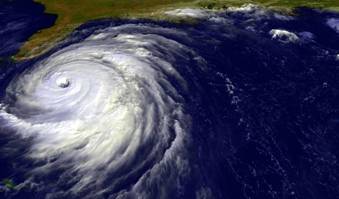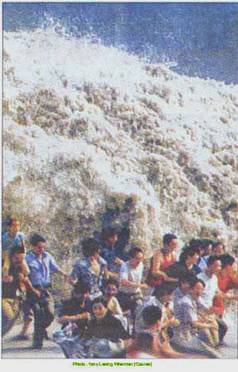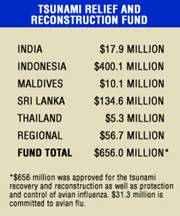TSUNAMI
Pre-reading
Read the following questions and guess what the answers are.
1. What is the meaning of Tsunami in Japanese? It means…
a.
splendid wave
b.
harbor wave
c.
giant wave
b.
tornado
2. How are Tsunamis generated? They are generated from…
a.
storm
b.
earthquakes
c.
pollution
d.
explosions
3. What might be the maximum height of Tsunamis?
a.
about 5 meters
b.
about 15 meters
c.
about 30 meters
d.
about 50 meters
4. What country spent the most for Tsunami relief and reconstruction
in 2004?
a.
b.
c.
d.
What does "tsunami" mean?
Tsunami is a Japanese word with the English translation,
"harbor wave." Represented by two characters, the top character,
"tsu," means harbor, while the bottom character, "nami,"
means "wave." In the past, tsunamis were sometimes referred to as
"tidal waves" by the general public, and as "seismic sea
waves" by the scientific community. The term "tidal wave" is a
misnomer; although a tsunami's impact upon a coastline is dependent upon the
tidal level at the time a tsunami strikes, tsunamis are unrelated to the tides.
Tides result from the imbalanced, extraterrestrial, gravitational influences of
the moon, sun, and planets. The term "seismic sea wave" is also misleading.
"Seismic" implies an earthquake-related generation mechanism, but a
tsunami can also be caused by a nonseismic event, such as a landslide or
meteorite impact.
How do tsunami differ from other water waves?
Tsunamis are unlike wind-generated waves,
which many of us may have observed on a local lake or at a coastal beach, in
that they are characterized as shallow-water waves, with long periods and wave
lengths. The wind-generated swell one sees at a

How do earthquakes generate tsunamis?
Tsunamis can be generated when the sea
floor abruptly deforms and vertically displaces the overlying water. Tectonic
earthquakes are a particular kind of earthquake that are associated with the
earth's crustal deformation; when these earthquakes occur beneath the sea, the
water above the deformed area is displaced from its equilibrium position. Waves
are formed as the displaced water mass, which acts under the influence of
gravity, attempts to regain its equilibrium. When large areas of the sea floor
elevate or subside, a tsunami can be created.
Large vertical movements of the earth's crust can occur at plate
boundaries. Plates interact along these boundaries called faults. Around the
margins of the
What happens
to a tsunami as it approaches land?
As a tsunami leaves the deep water of the open ocean and travels into
the shallower water near the coast, it transforms. A tsunami travels at a speed
that is related to the water depth - hence, as the water depth decreases, the
tsunami slows. The tsunami's energy flux, which is dependent on both its wave
speed and wave height, remains nearly constant. Consequently, as the tsunami's
speed diminishes as it travels into shallower water, its height grows. Because
of this shoaling effect, a tsunami, imperceptible at sea, may grow to be
several meters or more in height near the coast. When it finally reaches the
coast, a tsunami may appear as a rapidly rising or falling tide, a series of
breaking waves, or even a bore.
What happens
when a tsunami encounters land?
As a tsunami
approaches shore, it begins to slow and grow in height. Just like other water
waves, tsunamis begin to lose energy as they rush onshore - part of the wave
energy is reflected offshore, while the shoreward-propagating wave energy is
dissipated through bottom friction and turbulence. Despite these losses,
tsunamis still reach the coast with tremendous amounts of energy. Tsunamis have
great erosional potential, stripping beaches of sand that may have taken years
to accumulate and undermining trees and other coastal vegetation. Capable of
inundating, or flooding, hundreds of meters inland past the typical high-water
level, the fast-moving water associated with the inundating tsunami can crush
homes and other coastal structures. Tsunamis may reach a maximum vertical
height onshore above sea level, often called a runup height, of 10, 20, and
even 30 meters.

Relief and
Reconstruction Continues One Year After Tsunami
In
December 2004, a major earthquake followed by a tsunami hit Asia and
The
coastal areas of
As
the situation stabilized and survivors were provided with shelter and other
needs, rebuilding communities began.
Cash-for-work
programs give families incomes. Loans, business advice, and training in job
skills help develop new businesses and sources of income. Longer-term projects
to reconstruct water systems, roads, and other critical systems are under way.
In
their tsunami report card published in the December issue of Foreign Policy,
three experts give the relief effort a grade of A, citing both a quick response
and sustained commitment.
“The
disaster spurred into action governments, international organizations, and
hundreds of nongovernmental organizations,” wrote the three—Karl F. Inderfurth,
a former assistant secretary of state for South Asian affairs; David Fabrycky,
a professor at
“Relief
operations proceeded quickly and effectively. …The remarkable response
prevented the widely anticipated ‘second tsunami’ of disease and malnutrition,”
they concluded.

Struggling for
survival
Fishermen were
among those hardest-hit by the tsunami and many have received insufficient help
|
|
|
One year after
the tsunami, local fishermen still anticipate favourable tides for going back
to sea. Despite abundant donated boats, many still can't go out fishing as
they lack navigation equipment. |
|
|
|
Fishing piers
at Ban |
The plethora of
fishing boats busy plying the waters off Phuket and Phangnga may give the
impression that things have returned to normal after the tsunami. But
appearances belie a less comforting reality.
Fishermen, large
and small-scale alike, were among those hardest-hit by the Dec 26 tsunami. A
survey by the Thailand Development Research Institute estimated that around
5,800fishing boats were damaged in the six tsunami-ravaged provinces.
Even though help,
in the form of donations and state compensation, has poured in, many are still
struggling. The fishermen say the assistance is insufficient, and where they
have been given assistance, it is not appropriate to their needs.
Owners of a small
fishing boat received 66,000 baht for a missing boat. But if the boat was
damaged, they were given 30,000 baht towards the repair costs. The cost of a
new boat is 150,000 baht.
Owners of a deep
sea fishing vessel, anything longer than 10 metres, got 200,000 baht for the
loss while a new one costs three million baht. Those whose vessels were damaged
were given 95,000 baht.
Fishermen
complain about the low level of government compensation.
''How can I
recover? My boats cost over three million baht each. But I only received
200,000 baht in compensation. The compensation covered only the new boat's down
payment,'' said Amphan Chayasookkasem, formerly owner of a fleet of fishing
vessels.
Once a big
businesswoman with five boats, Mrs Amphan is now a vendor. Her house was
destroyed. She lost three out of nine family members in the tragedy.
''Can you imagine
that, how fast your life can fall apart? Before Dec 26, I was rich, successful
and happy. On the morning of Dec 26, I became poor and badly indebted.
Everything I had worked for for two decades was gone in 20 minutes,'' said Mrs
Amphan.
Sa-ard
Puangrayah, 42, said her life would never be the same.
''I once had
eight deep-sea boats. Twenty minutes after the waves came, I did not even have
any underwear to put on,'' Ms Sa-ard said while helping her workers pack fish
into baskets.
Rising oil prices
have aggravated the fishermen's plight.

Wrathful sea
The deadliest tsunami in modern history strikes the Andaman coast of
Phensiri
Jusirimongkhol, or 'Jae Wee', a well-known businesswoman in Ban Nam Khem, urged
the government to supply low-cost petrol if it really wanted to help fishermen
in Ban Nam Khem get back on track.
She said owners
of deep-sea boats were unfairly left out by the government and donors. ''They
thought we were already rich because we had bigger boats. But the bigger you
are, the larger the wound is,'' said Ms Phensiri, who once had 10 vessels and
her own private pier. Now she is left with one vessel and huge debts. Last
month, she faced charges of illegally building a pier on a public beach.
Small-scale
fishermen, the group considered to have received more help, suffered in their
own way.
A year after the
tragedy, 'Kai' or Chuchart Rattana, a 36-year-old fisherman, has still not
received a boat. He was told that he turned up too late for help and that the
donated boats had all been claimed. He complained that many fishermen simply
over-claimed and received excessive compensation. ''I was late because I spent
weeks trying to find my wife. At that time, how could I find time for anything
else?'' he said. His wife was drowned in the waves.
Some small-scale
fishermen who got donated boats could not go back to sea as the necessary
fishing equipment, sonar and radar devices for locating fish and underwater
rocks, and short-wave radios, were not provided. All complement of such
equipment costs around 100,000 baht.
Maitree
Chongkraichak, a councillor of Bang Muang Tambon Local Administration, said the
authorities refused to help with the necessary equipment.
''Provincial
officials told me that small-scale fishing is a traditional practice which does
not require help from technology,'' he said.
Apart from loss
of life and property, fishermen said they now face problems caused by
environmental changes.
In Ban Nam Khem,
the tsunami also wiped out a one-kilometre sand bar in front of the Ban Nam
Khem deep-sea piers. The sand bar served as a breakwater to shield the piers
against choppy waves. Now the sand bar has gone there is no natural harbour,
and no place for the deep-sea boats to dock.
Also gone with
the waves was Koh Pah, a tiny island near Ban Nam Khem village, which served as
a safe haven for small fishing boats. Without it, small boats have lost a vital
place to ride out storms.
Chukiet
Ngern-anek, an owner of deep-sea -boats in Phuket, said he worried that the
tsunami had changed underwater geography for good.
The waves also
destroyed spawning grounds, such as coral reefs, mangrove forests and the
seabed. The only good news was that fish stocks had not been depleted as had at
first been feared. Three months after the tsunami, deep-sea fishing boats were
returning to shore loaded with fish. The fish catch was even higher than that
of the same period in the preceding year.
''Fish came back
to the sea as if the tsunami had pulled them out of their bedroom,'' exclaimed
Mr Chukiet.
But now, deep-sea
boats are finding fewer fish and fishermen are beginning to worry again about
depletion. ''Rising oil prices are acceptable because the market will
eventually adjust to them. But if the sea environment has changed for good, we
will be in deep, deep trouble,'' said Mr Chukiet.
Praorai Nujmorn,
director of the Andaman Sea Fisheries Research and Development Centre -under
the Fisheries Department, sought to allay the fishermen's concerns about the
tsunami's effect on fish stocks, saying the marine ecology had recovered well.
''The sea's
condition is still good. Coral reefs are less damaged than we previously thought.
Our beaches are gradually improving,'' she said in a phone interview.
''We are lucky
when compared to Aceh [the hardest hit area, located in
The number of
fishing boats has increased, she said. Many fishermen she knows had been well
compensated for losses.
''It is good that
the villagers got help. But there are too many boats for the limited amount of
natural resources. If there are too many fishermen at sea, we will have a major
problem caused by over-fishing,'' she said.
Post-reading
Task 1: Understanding details
Write T in front of the correct statements and F in front of the
incorrect statements
_______1. Tsunamis are
sometimes referred to as "tidal waves".
_______2. Tsunamis are kind of wind-generated waves.
_______3. Rising oil prices have aggravated the fishermen's plight.
_______4. Most of the relief operations proceeded slowly and
non-effectively.
_______5. When they reach the coast, Tsunamis have no energy.
_______6. In
_______7. Tsunami
travels at a speed that is related to the water depth.
_______8. Subduction earthquakes are particularly effective in
generating tsunami.
_______9. In
_______10. Thai Fishermen complain about the low level of government compensation.
Task 2: Cloze
Fill in each blank with the most appropriate word given on the list.
shortage communication
gradually tracks government
beachside contaminated seabed
outbreak overall
1. The tsunami killed at least 216,000 people________. Nearly 2 million
lost their homes.
2. Survivors wept and prayed beside mass graves and at ________
memorials.
3. In
4. Owners of deep-sea boats were unfairly left out by the ________ and
donors.
5. The waves also destroyed spawning grounds, such as coral reefs,
mangrove forests and the ________.
6. There was _______ of food, medicines, clothing and other essential
items.
7. The water became ________ and the atmosphere was full of the stench
of human deaths.
8. Travel and ________ was also difficult in the initial days.
9.Life is ________ coming back to normal in all the villages.
Task 3: Vocabulary in
context
Look at the italicized words in the
following sentences. Then, choose the best synonyms for each one.
1. The term "tidal wave" is
a misnomer.
a.
well-known name
b.
general name
c.
wrong name
d.
scientific name
2. The term "seismic
sea wave" is also misleading.
a.
gigantic
b.
caused by earthquakes
c.
dangerous
d.
caused by wind
3. The water above the deformed area is displaced from its equilibrium
position.
a.
balance
b.
substance
c.
imbalance
d.
permanence
4. Wave energy is
dissipated through bottom friction and turbulence.
a.
regular air
b.
irregularity
c.
uncertainty
d.
violent air
5. The coastal areas of
a. great fortune
b. terrible event
c. calmness
d. predictable event
6. The remarkable response prevented the widely anticipated
‘second tsunami’ of disease and malnutrition
a. lack of basic necessities
b. poor health
c. bad sanitation
d. lack of food.
7. Six provinces are devastated.
a.
completely destroyed
b.
under reconstruction
c.
full of diseases
d.
poorly organized
8. Fishermen are beginning to worry again about depletion.
a.
great improvement
b.
great decrease
c.
completion of tasks
d.
harsh punishment
9. As the situation stabilized, survivors were
provided with shelter and other needs.
a.
became steady
b.
was renovated
c.
was stimulated
d.
became unstable
10. The fast-moving
water associated with the inundating tsunami can crush homes and
other coastal structures.
a.
aggressive
b.
giant
c.
unpredictable
d.
large amount
Vocabulary
|
Words |
Meanings
|
|
Seismic(adj.) Misnomer(n.) Equilibrium(n.) Boundary(n.) Continent(n.) Diminish(v.) Imperceptible(adj.) Turbulent(adj.) Malnutrition(n.) Calamity(n.) |
of earthquake wrong or inappropriate name state of balance line that delimits a country from another land masses of the earth make or become smaller or less important; not perceptible; can’t be seen or perceived violently agitated or disturbed insufficient nutrition; lack of food misfortune ; great disaster |
Answer Key
Pre-reading
1. b
2. b
3. c
4. d
Task 1: True-False
- T
- F
- T
- F
- F
- T
- T
- T
- T
- T
Task 2: Cloze
1.
overall
2.
beachside
3.
tracks
4.
government
5.
seabed outbreak
6.
shortage
7.
contaminated
8.
communication
9.
gradually
Task 3: Vocabulary
1.
c
2.
b
3.
a
4.
d
5.
b
6.
d
7.
a
8.
b
9.
a
10.
d
Contributors
Surakit
Chompaisal
Voraporn Komain
Charnchai Chitpatanapaibul
Nattavadee
Techavijitpaisarn
Editor
Antikar Rongsa-ard




